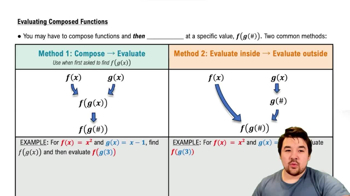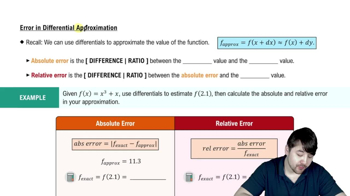Table of contents
- 0. Functions7h 52m
- Introduction to Functions16m
- Piecewise Functions10m
- Properties of Functions9m
- Common Functions1h 8m
- Transformations5m
- Combining Functions27m
- Exponent rules32m
- Exponential Functions28m
- Logarithmic Functions24m
- Properties of Logarithms34m
- Exponential & Logarithmic Equations35m
- Introduction to Trigonometric Functions38m
- Graphs of Trigonometric Functions44m
- Trigonometric Identities47m
- Inverse Trigonometric Functions48m
- 1. Limits and Continuity2h 2m
- 2. Intro to Derivatives1h 33m
- 3. Techniques of Differentiation3h 18m
- 4. Applications of Derivatives2h 38m
- 5. Graphical Applications of Derivatives6h 2m
- 6. Derivatives of Inverse, Exponential, & Logarithmic Functions2h 37m
- 7. Antiderivatives & Indefinite Integrals1h 26m
- 8. Definite Integrals4h 44m
- 9. Graphical Applications of Integrals2h 27m
- 10. Physics Applications of Integrals 2h 22m
4. Applications of Derivatives
Differentials
Problem 4.8.45
Textbook Question
{Use of Tech} Newton’s method and curve sketching Use Newton’s method to find approximate answers to the following questions.
Where are the inflection points of f(x) = (9/5)x⁵ - (15/2)x⁴ + (7/3)x³ + 30x² + 1 located?
 Verified step by step guidance
Verified step by step guidance1
To find the inflection points of the function \( f(x) = \frac{9}{5}x^5 - \frac{15}{2}x^4 + \frac{7}{3}x^3 + 30x^2 + 1 \), we first need to find the second derivative, \( f''(x) \).
Calculate the first derivative \( f'(x) \) by differentiating \( f(x) \): \( f'(x) = \frac{d}{dx}\left(\frac{9}{5}x^5 - \frac{15}{2}x^4 + \frac{7}{3}x^3 + 30x^2 + 1\right) \).
Differentiate \( f'(x) \) to find the second derivative \( f''(x) \). This involves applying the power rule to each term of \( f'(x) \).
Set \( f''(x) = 0 \) to find potential inflection points. Solve this equation to find the critical points where the concavity might change.
Use Newton's method to approximate the roots of \( f''(x) = 0 \). Start with an initial guess \( x_0 \) and iterate using the formula \( x_{n+1} = x_n - \frac{f''(x_n)}{f'''(x_n)} \) until the values converge to a satisfactory level of precision.
 Verified video answer for a similar problem:
Verified video answer for a similar problem:This video solution was recommended by our tutors as helpful for the problem above
Video duration:
11mPlay a video:
Was this helpful?
Key Concepts
Here are the essential concepts you must grasp in order to answer the question correctly.
Newton's Method
Newton's Method is an iterative numerical technique used to find approximate solutions to equations, particularly for finding roots of functions. It utilizes the function's derivative to refine guesses, starting from an initial estimate. The method is effective for functions that are continuous and differentiable, allowing for rapid convergence to a solution when the initial guess is close enough.
Recommended video:

Evaluating Composed Functions
Inflection Points
Inflection points are points on a curve where the concavity changes, indicating a shift in the direction of curvature. To find inflection points, one must compute the second derivative of the function and determine where it equals zero or is undefined. These points are significant in curve sketching as they help identify changes in the behavior of the graph, such as transitions from concave up to concave down.
Recommended video:

Critical Points
Second Derivative Test
The Second Derivative Test is a method used to classify critical points of a function by analyzing the sign of the second derivative. If the second derivative is positive at a critical point, the function is concave up, indicating a local minimum; if negative, it indicates a local maximum. If the second derivative is zero, the test is inconclusive, and further analysis is needed to determine the nature of the critical point.
Recommended video:

The Second Derivative Test: Finding Local Extrema







